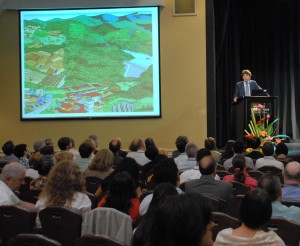Toss clichés aside and consider gender in ‘landscape’ context — expert says
NOTE: This text is reblogged from the CIFOR blog post at http://blog.cifor.org/20697/toss-cliches-aside-and-consider-gender-in-landscape-context-expert#.Us022ifzzTO
***********************************************************

We need to challenge our own blind spots and put gender research into practice, said Esther Mwangi, a senior scientist with the Forests and Governance Program at the Center for International Forestry Research. CIFOR/Ollivier Girard
WARSAW, Poland (18 December 2013) — Crafting development strategies based on credible research results rather than relying on outdated, unsubstantiated statistics will eliminate gender stereotypes and boost the fight against climate change, a development expert says.
Steering sustainable development polices toward a “landscapes approach” framework, which applies an integrated approach to land management, will make the relevance of gender to environmental debates even more apparent, said Seema Arora-Jonsson, associate professor of rural development with the University of Agricultural Sciences in Uppsala, Sweden.
Spotlight #15 – Planted forests’ roles: Different strokes for different oaks
Planted forests’ roles: Different strokes for different oaks
Planted forests are vital but vulnerable resources that can contribute in a sustainable fashion to some of humanity’s most pressing needs – poverty alleviation, food security, renewable energy, mitigation of and adaptation to climate change, and biodiversity conservation – as well as the preservation of natural forests.
These are among the findings in the recently published Summary Report of the 3rd International Congress on Planted Forests. It is based on outcomes from three scientific workshops and a plenary meeting that took place earlier this year.
Thirty-three countries have greater than 1 million hectares of planted forest area. Together these countries comprise 90% of the world’s 264 million hectares of planted forest which, in turn, equals almost 7% of the total global forest area. The report takes into account key research findings from Africa, Asia, Europe, Oceania, Latin America and North America related to vulnerability, viability and governance of planted forests.
IUFROLAT Inaugural Address: Climate Smart Territories
Jose J Campos, Director General, CATIE, took centre stage once again giving an inspiring presentation entitled, “Climate smart territories- fostering production, resilience and reduced emissions through socially inclusive land management.” He opened by saying that it is important to think and to work on the territorial level. We should strive to optimize the goods and services in a territory, and to craft a vision with the different players in a territory. It is possible to diversify the economy and recover forest coverage, and noted that countries such as South Korea, and Finland are already doing so.
He stressed what is needed is collective actions from stakeholders; to give a positive result in a territory and ensure that we can improve our landscapes. He noted that this will take indigenous knowledge, new technologies, increased research and time, and it is important not to be spontaneous in how we approach the problems.
Key messages from his presentation include:
- Global challenges increasingly threaten human security; climate, food, water, energy, etc.
- System approaches (livelihoods, territorial, sustainable production and value chains) could effectively manage synergies and trade-offs among global challenges.
- There is a need for collective action through effective local governance and co-management of natural resources.
- “Climate smart technologies” are a tool that links top=down and bottom-up actions for collective impact.
He continued to explain that we do not need to reinvent the wheel. We need to find territories and existing projects to use as a model. He finished by saying that the key to this is in future professionals and in new interdisciplinary science. He stated there is a need to link students to ongoing development initiatives through fieldwork and case studies, to link their education to research, to local development processes and their contributions to society. If we work together we can create a virtuous circle for inclusive and sustainable human well-being.


